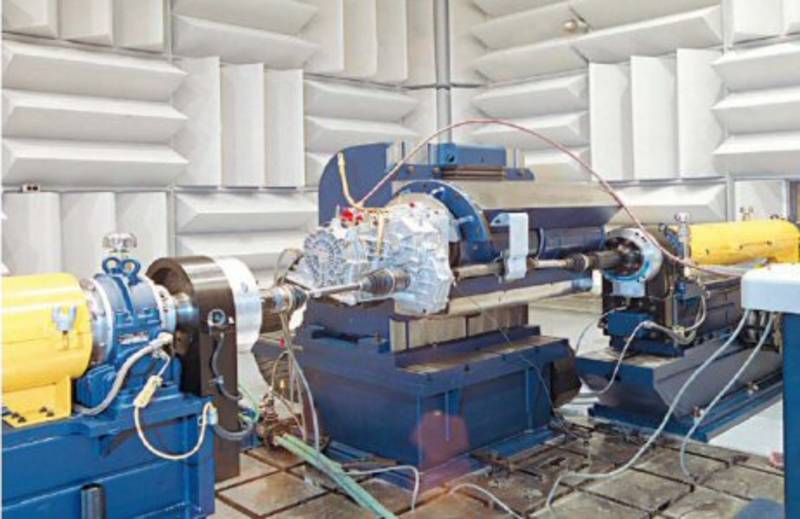ETPS
Engine Torque Pulse Simulation
HORIBA has revolutionized the way vehicle manufacturers test their Powertrains and Front End Accessory Devices. The ETPS dynamometer system accurately produces torsional pulse characteristics of an engine. This new technology employs a sophisticated mathematical model to calculate the resulting torque at the output of the engine based on engine and combustion process parameters.
ETPS - Drive Train Development
To help vehicle manufacturers achieve the ultimate goal of customer satisfaction (durability, driving characteristic, and NVH), transmission and component suppliers must continue to improve upon existing transmissions, as well as develop new powertrains without the aid of an existing engine. Testing technology available to OEMs before the ETPS system was hampering this effort. Until now, the prime mover for test stands was either a fueled engine or an AC motor. Fuelled engine prime movers are expensive to maintain considering the costs for fuel, lubrication, heat removal, engine maintenance and repair, as well as maintaining building codes and fire protection. The calculated torsional pulse response is created on the output shaft of the ETPS dynamometer system by the ultra-low inertia dynamometer and an adaptive closed-loop, real time controller the HORIBA SPARC®. The SPARC® controller continually assures that the calculated torque profile is actually achieved as an excitation (dynamic input) to the test specimen. The ETPS dynamometer system predicts the high frequency torsional pulses of a piston powered engine, Files can be created to simulate engines under development even before they are running prototypes.
Applications
- ETPS - Engine Torque Pulsation Simulation Dynamometer Front Wheel Driven Transmission testbed, used for testing transmission under NVH conditions
- Noise, Vibration and Harshness analysis of transmissions and drivelines
- Development of the driving experience at the transmission and driveline
- Durability
Technical Advantages
- Simulation of complete engine torque signature
- Any car or truck engine can be selected
- High fidelity reproduction of engine vibration
- Very low noise emissions from test support devices
In order to produce high fidelity torque pulses, physical properties of traditional dynamometers become practical limitations. These include shaft connection stiffness, large attached inertia, and torque measurement techniques. The HORIBA ETPS dynamometer system overcomes all of these restrictions. ETPS allows the testing of driveline components or systems to be accomplished without a fuelled engine in the test cell. This capability offers a tremendous cost and time savings to the vehicle development engineers. Additional advantages of ETPS are the capability to perform driveline tests in parallel with engine design and testing. No delays in testing due to prototype engine build. The need for complex real- time hardware in the loop (HIL) simulators as well as the need for field-recorded data is eliminated. The flexible test environment provided by ETPS ultimately provides shorter vehicle development cycles and more accurate and efficient testing.
Benefits for electric dynamometer as an input
- Simplicity of test cell support facilities
- Parallel Development Process by simulating any engine (even a non-existent prototype engine)
- Experiments to define engine characteristic for optimal vehicle performance
- Repeatability of input for shift calibration and shift realism
- Isolated NVH testing and problem resolution
- High Investment and Maintenance Cost for Engine Driven Test Rigs-Environmental protection laws-Fuels, lubrication-Maintenance of a “golden engine”
Applications
- “Instant” engine configuration changes by software that recognizes from single cylinder to V16, different fuel types, and displacements
- Dynamic torque feedback measurements compatible for either manual or automatic transmissions directly connected to the dynamometer without torque transducer
- Complete engine torque performance environment, including;
engine map (torque speed – throttle position), braking torque, and IC engine order harmonics - Unique Idle condition simulation (power consuming accessory load without increase in shaft torque)
- Speed sweep or throttle sweep diagnostic tools for NVH investigations
- Ultra-low inertia dynamometer (matches ICengine) for transmission shift calibration
- Mechanically intuitive -- direct “shaft-less”interface to test article and small diameter (<300mm) for minimal or no “test fixture” influences
- X-Y-Z position translation for setting operational centerline height location
- Self-contained audible noise attenuation and vibration dampening housing
- Low audible noise source in the frequencies between 40Hz and 8kHz
- Wide range of connected inertia capability (up to 0.5 kg-m2) without introducing an artificial torsional resonance that affects engine order harmonic frequency generation capability
- Control and communications interface compatible with most test automation systems, ECU’s and PCU’s
